

Maker Education. Make: Education. We believe that making can transform the way we all learn, from preschoolers through retirees.
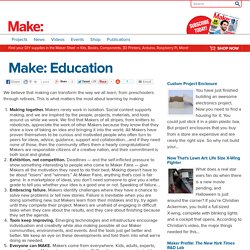
This is what matters the most about learning by making: Making together. Makers rarely work in isolation. Social context supports making, and we are inspired by the people, projects, materials, and tools around us while we work. We find that Makers of all stripes, from knitters to roboticists, appreciate the work of other Makers because they know that they share a love of taking an idea and bringing it into the world. Maker Faire Education. Teachers: to be notified of events, discounts, and freebies, please be sure to join our Maker Faire Education Community.
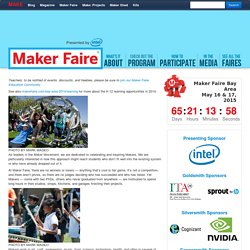
See also makerfaire.com/bay-area-2014/learning for more about the K-12 learning opportunities in 2014. As leaders in the Maker Movement, we are dedicated to celebrating and inspiring Makers. We are particularly interested in how this approach might reach students who don’t fit well into the existing system or who have already dropped out of it. At Maker Faire, there are no winners or losers — anything that’s cool is fair game. It’s not a competition, and there aren’t prizes, so there are no judges deciding who has succeeded and who has failed. Top ten ways to start with “maker education” This is possibly the question I hear most frequently – “Where do I start incorporating making in my classroom?”
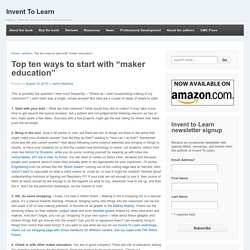
I wish there was a single, simple answer! But here are a couple of ideas of where to start. 1. Start with your kids – What are their interests? What would they like to make? 2. 3. 4. Twitter – the #makered hashtag is very active with global contributions of links and projects. 5. 6. 7. 8. How the Maker Movement Is Moving into Classrooms. The Maker movement is a unique combination of artistry, circuitry, and old-fashioned craftsmanship.
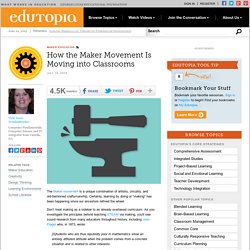
Certainly, learning by doing or "making" has been happening since our ancestors refined the wheel. Don’t treat making as a sidebar to an already overtaxed curriculum. As you investigate the principles behind teaching STEAM via making, you'll see sound research from many educators throughout history, including Jean Piaget who, in 1973, wrote: [S]tudents who are thus reputedly poor in mathematics show an entirely different attitude when the problem comes from a concrete situation and is related to other interests.
In 1972, Seymour Papert predicted what many complain is the state of today's apps and programs for modern students: [T]he same old teaching becomes incredibly more expensive and biased toward its dumbest parts, namely the kind of rote learning in which measurable results can be obtained by treating the children like pigeons in a Skinner box. Making Matters! How the Maker Movement Is Transforming Education. By Sylvia Libow Martinez and Gary S.
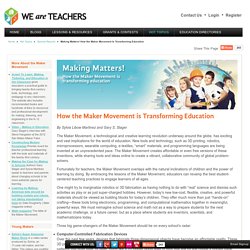
Stager The Maker Movement, a technological and creative learning revolution underway around the globe, has exciting and vast implications for the world of education. New tools and technology, such as 3D printing, robotics, microprocessors, wearable computing, e-textiles, “smart” materials, and programming languages are being invented at an unprecedented pace. The Maker Movement creates affordable or even free versions of these inventions, while sharing tools and ideas online to create a vibrant, collaborative community of global problem-solvers. Fortunately for teachers, the Maker Movement overlaps with the natural inclinations of children and the power of learning by doing. One might try to marginalize robotics or 3D fabrication as having nothing to do with “real” science and dismiss such activities as play or as just super-charged hobbies.
Three big game-changers of the Maker Movement should be on every school’s radar: Celebrating Young Talent. Maker Education Initiative – Every Child a Maker. Maker Movement Reinvents Education. Lectures are so old school; the Maker Movement is reinventing education You’ve hit your limit of 5 free articles this month.Try our subscription options: Weekly home delivery with free shipping, access to Newsweek’s web site, and the complete online archive Access to Newsweek’s web site, and the complete online archive.
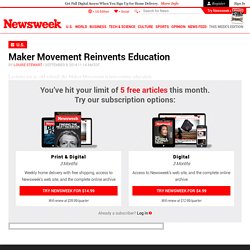
Creating an Authentic Maker Education Rubric. While many teachers are excited about the maker movement and may even be creating projects for their classrooms, assessment can be puzzling even to veteran classroom teachers.

How can teachers prove that deep, rich learning is occurring through making? How do we justify a grade to students and parents alike, especially to the student who "just isn’t good at art"? By crafting a three-part rubric that assesses process, understanding, and product, teachers can rest assured that they are covering all the bases. Part 1: Process The process of making in the classroom needs to be incorporated in the final grade. Photo credit: Lisa Yokana As part of a recent project in my school's senior-level public policy class, students crafted scale models of Lower Manhattan in preparation for a disaster simulation.
Students created a scale model of Lower Manhattan in City 2.0 at Scarsdale High School. Part 2: Understanding Students must demonstrate an understanding of materials and tools.